江苏南通小升初英语语法点总结及练习
小升初苏教版36年级小学英语语法大全经典全面

题目:I have a _____ (blue) book. 答案解析:正确答案为“blue” 解析:形容词修饰名词,表示事物的性质。
• A. is; father B. are; father • 答案:B • 解析:句意:你父亲长什么样?What be sb like?某人长什么样?主语your father是第三人称单数,be动词用is,故选B。
• 题目:This is _______ orange. _______ orange is in the box. A. an; An B. an; The C. the; The D. the; An 答案:B 解析:句意:这是一只橘 子。这只橘子在盒子里。表示泛指用不定冠词a/an,orange是以元音音素开头的,所以用an;表示特指用定冠词the,根据句意,故选B。
形式:虚拟语气有多种形式,包括简单虚拟语气、复合虚拟语气和虚拟语气从句等。在苏教版 教材中,主要学习的是简单虚拟语气。
注意事项:在学习虚拟语气时,需要注意与真实语气的区别,掌握其基本用法和常见搭配,以 及在不同语境下的含义和用法。
倒装句的分类:前置倒装和 后置倒装。
倒装句的定义:句子结构与 正常语序相反,强调某个词 语或表达方式。
四年级下册:一般 过去时态,情态动 词
添加标题
六年级下册:主谓 一致和倒装句
规则变化:直接 在名词后加“s”
不规则变化:如 child的复数为 children
特殊变化:如 man的复数为 men
不可数名词:如 water,milk等 没有复数形式
2023年小升初英语语法总结及习题形容词和副词的比较级

形容词副词比较级最高级练习题(一)写出下列形容词与副词的比较级与最高级形式:long __________ __________ wide ____________ __________fat __________ __________ heavy __________ __________slow __________ __________ few __________ __________badly __________ __________ difficult __________ __________far __________ __________ quickly _________ ___________happy __________ __________unhappy __________ __________fast __________ __________ wide __________ __________easy __________ __________ small __________ __________large ________ _________ dirty __________ __________long __________ __________ rude __________ __________busy _______ __________ hot __________ __________thin ________ _________ fat __________ __________few __________ __________ good / well __________ __________little________ _________ busy __________ __________ill / poor / bad / /badly __________ __________old __________ __________ thin __________ __________many / much __________ __________slow__________ __________ delicious _______________ _____________tidy __________ __________ careful __________ __________ hard ____________________ nice __________ __________brave __________ __________ pretty __________ __________lazy __________ __________ dirty __________ __________dry __________ __________ busy __________ __________slim __________ __________(二)、用所给词的对的形式填空:1.Which is_________(easy)to learn , fishing or swimming?2.Shanghai is larger than _________city in Sichuan.3.In Changchun , the Jing Yue Forest Park is much_____ (clean)than that in the center of the city.4.It makes__________ (little)time to go to Beijing by plane than by train5.Mum,this T-shirt is much too small for me. Would you buy me a_____________(large)one?6.Xi'an is one of _____________(old)capital in China.7.____________(few)children there are in a family,_____________(good)their life will be.8.It will be bad for your health to eat __________(much)food and take__________(little)exercise.9.Now China has joined WTO, so I think English is_____________(useful)than before.10.Of all his subjects, Tom is_____________(good)at English.11.Who is_____________(interested)in Chinese in your class at the moment?12.Book II is_____________(different)than Book IV.13.The Great Wall of China is one of ______________________(great)wonders in the world14.She is becoming_____________(beautiful)than before.15.The weather in Fujian is better than_____________ in Wuhan.16.The texts in Book II are much easier than _____________in Book IV.17.The weather is getting _____________ and_____________(cold).18.The _____________(much),the_____________ (good).19.The_____________(much)you practice, the_____________(easy)it becomes.20.Which lesson is _______________________ (difficult) in Book 2?21.Alice writes ______________________(carefully ) than I.22.This story is _____________________( interesting) than that one.23.This kind of food must be _________________ ( delicious )than that one.24.Beihai park is one of ____________ (beautiful ) parks in Beijing.25.Who’s _________________(careful), Tom, Jim or Kate?26.That is _________________(easy) of all.27.He is ___________________(clever )boy in the class.28.John is _________________( short) than Tom.29.She is __________________(pretty)girl in the group.30.Can you show me________(near) shop here?31.This bridge is as _______ ( long) as that one, but it is much ______ (wide) than that one.32.I thought English is one of _________ (important )subjects in middle school.33.I am only one year ________ (young) than you..34. Miss Chen is __________ _________than Mr. Wang. (popular)35. The basketball _______ ________ ________ the baseball. (big)36. Question A _______ ________ _________ ________ Question B. (important)37. Toronto is ______________ _______________ city in Canada. (large)38. Playing computer games is_______________ _______________ _______________ of all the activities.(interesting).39. The Nile(尼罗河) is _______________ _________________river in the world. (long)40. Good health is _______ _______ ________thing life. (important)41. Taking a taxi is _______________ ________________ way to get to the airport. (easy)42. Test 1 is _____ _______ _________of all the tests.(difficult)43. He is ________than any other boy in the class.(clever)44. She is________________ than all the other students. (young)45. The window is ________ ________ of the two. (narrow)46. Where is the _________________bus-stop? (near)47. He is one of ________ ________ _______Politicians. (famous)48. Tom drives much ________ ________than John. (careful)49. The white flower is ________(beautiful). The yellow flower is _____________ (beautiful)than the white flower. The red flower is the _____________ _______________ of the three.50. Which is ________________ (big),the sun, the moon or the earth?51. Which is _______________ (beautiful), the black coat or the blue one?52. This moon cake is _____________ (cheap) of all.53. He is ________________ (strong) in the class.54. English is _____________ (widely) spoken in the world.(三)、翻译句子:1.这本书比那本书好多了。
江苏南通小升初英语语法点总结及练习
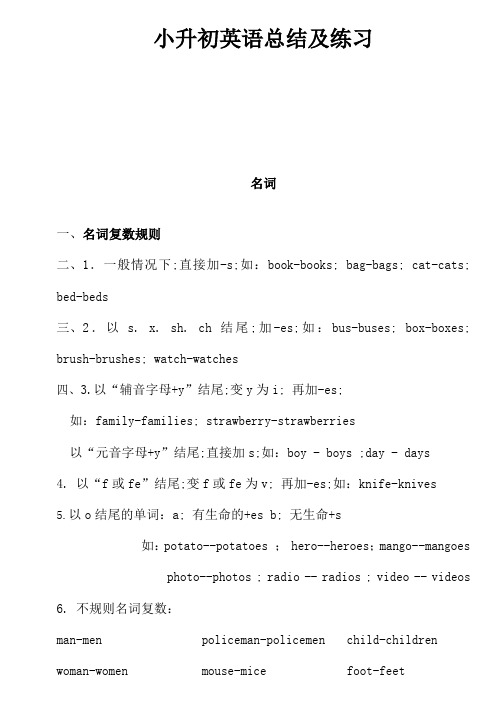
小升初英语总结及练习名词一、名词复数规则二、1.一般情况下;直接加-s;如:book-books; bag-bags; cat-cats; bed-beds三、2.以s. x. sh. ch结尾;加-es;如:bus-buses; box-boxes; brush-brushes; watch-watches四、3.以“辅音字母+y”结尾;变y为i; 再加-es;如:family-families; strawberry-strawberries以“元音字母+y”结尾;直接加s;如:boy - boys ;day - days4. 以“f或fe”结尾;变f或fe为v; 再加-es;如:knife-knives5.以o结尾的单词:a; 有生命的+es b; 无生命+s如:potato--potatoes ; hero--heroes;mango--mangoes photo--photos ; radio -- radios ; video -- videos 6. 不规则名词复数:man-men woman-women policeman-policemenmouse-micechild-childrenfoot-feettooth-teeth fish-fish people-people Chinese-ChineseJapanese-Japanesedeer - deersheep-sheeppolicewoman-policewomen二、名词所有格的构成法1. 主要是在词尾加’ s 构成..如:This is Tom’s desk . 这是汤姆的书桌..That is Mike’s book. 那是迈克的书..2. 如果原名词已经有复数词尾s ;则仅加一个’ . 如:the teachers’ reading room 教师阅览室the pupils’ pencil-boxes 学生们的文具盒3. 如果原词是复数形式;但不是以s 结尾; 变为所有格形式需在后面加上’ s ..如:the children’s palace 少年宫men’s room 男厕所名词所有格口诀:名词所有格;s前面加一撇’;复数s放在尾;后加一撇就完结;两人共有算一个;后面只加一个撇..基础练习题一、写出下列名词的复数形式1puter ____________ 2.apple ____________ 3.city ______________4.house _____________5.sheep _____________6.watch ______________7.tomato _____________ 8.child _____________ 9.tooth ________10.foot ______________ 11.wife _____________ 12.potato ____________13.play _____________ 14.day ____________ 15.glass ______________16.radio ______________ 17.zoo ______________ 18. life ______________19. story _____________ 20.leaf _____________ 21. baby _____________22.dress _____________ 23.butterfly _____________ 24. deer _____________25.class _____________ 26.brush _____________ 27.key _____________28. English ____________29.mouse ____________ 30. man _____________二、汉译英1.Tom的足球_________________ 2. 老师们的自行车_________________3.学生们的课桌_________________ 4.哥哥的文具盒_________________5.姑姑的卡片_________________ 6.猴子们的香蕉_________________7.蚂蚁们的早餐 _________________ 8.妈妈的包_________________ 9.姐姐的连衣裙_________________ 10女孩们的苹果_________________三、把下列句子翻译成英文1.这些是Peter的篮球吗 ________________________________________ 2.这个是老师的钢笔吗___________________________________________3.有一些书在Sam的课桌上..________________________________________4.有一些孩子们在教室里..___________________________________________四、改错圈出错处;在横线上改正过来1.There are some butterflys on the table. ________________________2.This is Alice dress. ______________________3.I like tomato very much. __________________五、将下列句子变成复数形式..1.This dog is brown.___________________________________________________2. There is a book and a pen on the table.___________________________________________________3.That woman is a teacher.___________________________________________________能力提升题一、将下列名词变成复数形式..1. plane tree lesson month apple shirt2.box bus brushwatch class fox 3. knife life leaf Wife thief4. day boy monkey baby country story5. photo radio piano tomato hero6.child tooth manSheep English Chinese 二、判断正误;并改正错句;正确的打“ √ ”1.The house is my brother. ________________________2. He has visited many country. ______________________3. They are Englishs. ______________________________4. This is Tom red bike. ____________________________三、选择填空1.There are two ______ in the room.A. ChinesesB. Englishman2.The old man will have ___________ out.A. two toothsB. two teeth3. ____________ are sold in this bookstore.A. Children’s booksB. Children books4. Some friends of _________ will come here.A. John’sB. John5. Can you give me ______________A. some papersB. a piece of paper6.There are ______________ on the floor.A. some boxB. some boxes四、将下列句子变成复数形式..1.This sheep is white __________________________________2. There is a desk and a chair in the room._____________________________3.That man is a doctor. ________________________________代词一、人称代词人称代词即表示“你、我、他、你们、我们、他们”等的词;它的人称、数和格的变化见下表:主格与宾格:人称代词有主格和宾格两种形式..主格主要用来做句子的主语;宾格主要用作宾语..人称代词主格用在句首作主语..She is sitting in a bus.她正坐在公共汽车上..人称代词宾格在动词后作宾语..I saw her yesterday.我昨天看到她了..二、物主代词物主代词是表示所有关系的代词;分为形容词性物主代词和名词性物主代词..名词性物主代词 = 形容词性物主代词 + 名词例;Whose coat is this 这是谁的上衣It’s hers. 是她的.. hers= her coat关于物主代词的口诀:物主代词很重要;译成汉语都有“.....的”;后面必须加上物;否则就要犯错误;my your his her its our their 不放过..形容词性是基础;除了我的“mine”外;其他词尾“s”性形物代能力差;出门常把名词加;名物代能力强;常来独去又独往..三、反身代词反身代词也叫“自身代词”;表示“自己”..I can do it by myself. 我自己能做这件事..反身代词的构成规律记忆口诀:反身代词有规律;第三人称宾格加;其余开头用物主;复数-ves替-f四、指示代词This 这个------- these 这些指近处的事物That 那个------- these 那些指远处的事物例;This is a book. 这是本书.. These are some books. 这些是书..That is a car. 那是辆小汽车.. Those are some cars. 那些是小汽车..基础练习题一、根据题意;用所给词的适当形式填空..1.Mary is a friend of ______________. I2.This is ________ she ruler. ________ I is in the bag.3.Her brother is too young to look after _________ he4.This is _________ I book. This book is _________ I .5.These pens are _________ we .二、填写下列表格..三、改写下列句子Eg; This is my book. ------ The book is mine.1.That is her ruler.____________________________________2.These are their footballs._____________________________________3.This is my backpack ._____________________________________4.Those are your boxes._____________________________________四、把下列句子改写成复数..1. This is a butterfly. ______________________________________2. That is a bus. ______________________________________3. It is a mouse. ______________________________________五、改错..1.This is mine lamp. ______________________________________2.These are ours books. _______________________________________3. That are their teacher. ______________________________________4.The house is my brother. _______________________________________5. He has visited many country. _______________________________________6. They are Chineses. _______________________________________7. This is Tom red bike. _______________________________________能力提升题一、帮下面的好朋友团圆连线I 她its 我们her 他她;它们we 我they 你的their 他她;它们your 她的she 它的二、填空1.She’s a teacher . This is _________ bag.2. He’s a driver. This is ___________ taxi.3. I am a boy . __________ name is Peter.4. --What’s __________ name-- My name is Tony.5. It’s my puppy. ______ name is Mimi.三、选择1.Your book is not so old as _________.A. himB. heC. hisD. she2. _____ book is it It’s ________.A. Whose…herB. Whose… hersC. Who…hersD. Whom…her3. He is a friend of ________.A. ourB. usC. myD. mine四、改错1. I; you and he are all teachers. ____________2. This is mine teddy bear. ____________3. These are ours bags. ____________4. These is their teachers. ____________。
小升初英语语法复习要点练习题

TTA standardization office [TTA 5AB・ TTAK 08・ TTA 2C]小升初英语语法复习要点不规则动词变化表不规则动词变化表词义现在(原形)过去-ing形(动名词)是am (be) was being? 切cut cut cutting?是are (be) were being? 做do. does did doing?是be was, were being? 固draw drew drawing?成为become became becoming? 饮drink drank drinking?开始begin began beginning? 吃eat ate eating?弯曲bend bent bending? 感觉feel felt feeling?吹blow blew blowing? 发现find found finding?买buy bought buying? 飞fly flew flying?能can could........... 忘记forget forgot forgetting? 捕捉catch caught catching? 得到get got getting?选择choose chose choosing? 给give gave giving?来come came coming? 走go went going?成长grow grew growing? 放置put put putting?有have, has had having? 读read read reading?听hear heard heiiring? 骑、乘ride rode riding? 受伤hurt hurt hurting? 响、鸣ring rang ringing? 保持keep kept keeping? 跑run ran ninning?知道know knew knowing? 说say said saying?学习learn learned, learnt learning? 看见see saw seeing?允许,让let let letting? 将shall should -----躺lie lay lying? 唱歌sing sang singing? 制造make made making? 坐下sit sat sitting?可以may might ----- 〔帝觉sleep slept sleeping?意味mean meant meaning? 说speak spoke speaking?会见meet met meeting? 度过spend spent spending 必须must must ------补充:与出下列词的完全形式缩略形式he,s ______ she,s ______ I’m _______ i sn't can,t _______ r d _________ aren^t ________ thwhen's didn't you* re doesn't小升初英语语法复习要点讲解和练习代词人称代词和物主代词1、人称代词主格和宾格的区别:主格通常位于句中第一个动词之前(有时候位于than之后),宾格一般位于动词或介词之后。
2024小升初英语必考语法知识点归纳

2024小升初英语必考语法知识点归纳2024字小升初英语考试是学生们升入初中的重要关卡之一,英语语法是考试重点和难点。
以下是2024小升初英语必考的语法知识点归纳,供同学们参考复习。
一、动词时态1.一般现在时:表示经常性的动作或客观事实。
例如:I go to school every day.2.现在进行时:表示现阶段正在进行的动作。
例如:She is studying English now.3.一般过去时:表示已经完成的过去的动作。
例如:I watched a movie last night.4.过去进行时:表示过去一些时间段正在进行的动作。
例如:They were playing chess this morning.5.将来时:表示将来要发生的动作或存在的状态。
例如:I will go on a trip next week.6.过去将来时:表示过去一些时间节点上将要发生的动作。
二、名词1.可数名词与不可数名词:可数名词有单数和复数之分,不可数名词只有单数形式。
例如:table(可数), water(不可数)2.名词所有格:表示所有关系时,在名词后加's。
例如:Tom's book(汤姆的书)3.复合名词:由两个或两个以上名词构成并有一定结构的名词。
例如:classroom, basketball三、形容词与副词1.形容词用来修饰名词,副词用来修饰动词、形容词或其他副词。
例如:She is a beautiful girl.(形容词修饰名词)He runs fast.(副词修饰动词)2. 形容词的比较级和最高级:一般在形容词后面加-er表示比较级,在形容词前面加the最高级。
例如:He is taller than me.(比较级)He is the tallest boy in our class.(最高级)四、代词1. 人称代词:主格形式有I, you, he, she, it, we, they;宾格形式有me, you, him, her, it, us, them。
小学六年级英语语法小升初英语语法总结及习题

小学六年级英语语法小升初英语语法总结及习题-小升初英语语法英语语法总结及习题现在进行时发布小学小升初英语语法总结及习题现在进行时,更多小学六年级英语语法小升初英语语法总结及习题现在进行时相关信息请访问。
现在进行时1现在进行时表示现在正在进行或发生的动作,也可表示当前一段时间内的活动或现阶段正在进行的动作。
动词ing。
动词调到句首。
5现在进行时的特殊疑问的基本结构为:疑问词不达意be 主语动词ing但疑问词当主语时其结构为:疑问词不达意 be 动词ing动词加ing的变化规则1一般情况下,直接加ing,如:coo-cooing结尾,去e加ing,如:mae-maing, taste-tasting3如果末尾是一个元音字母和一个辅音字母,双写末尾的辅音字母,再加ing,如:run-running, stoe ________get_________stoe girls _______________ singin the classroom3 My mother _________________ coosome nice food now4 What _____ you ______ do now5 Loo They _______________ have an English lesson____________not ,water the flowers now! the girls ________________dance in the classroom is our granddaughter doing She _________listen to music9 Its 5 ocloc now We _____________havesu改一般疑问句并作肯定和否定回答__________________________________________________ _______________________________________________________今天就为大家介绍到这里,!。
小升初英语语法总结讲解与练习

小升初英语语法总结讲解与练习一、一般现在时一般现在时表示经常性或习惯性的动作,也可表示现在的状态或主语具备的性格和能力。
当时间是频度副词always,often,sometimes,usually等时,使主语具备的性格和能力。
例如:Healwayscomes to school on time.他总是按时到校。
当主语是第三人称单数时,谓语动词要用第三人称单数形式,例如:Helikes English.他喜欢英语。
动词be的第三人称单数形式是is,否定式是isnot,过去式是was。
例如:Heis a student.他是一名学生。
He is not astudent.他不是一名学生。
二、现在进行时现在进行时表示正在进行的动作,由"be+现在分词"构成。
例如:How areyou studying?你正在怎样学习?三、现在完成时现在完成时表示动作发生在过去但与现在有,由"have+过去分词"构成。
例如:Have you finished your homework?大家的作业写完了吗?小升初英语语法总结一、动词时态一般现在时定义:表示通常性、规律性、习惯性的状态或者动作(有时间规律发生的事件)的一种时间状态。
用法:1、表示经常性或习惯性的动作或存在的状态。
2、表示主语具备的性格和能力。
3、表示不受时间限制的真理或事实。
例句:I have a pen.我有一支钢笔。
He always goes to school by bike.他总是骑自行车去学校。
They work hard all day.他们整天努力工作。
There is a book on the table.桌子上有本书。
二、现在进行时定义:表示现阶段或说话时正在进行的动作及行为。
用法:1、表示一个正在进行的动作。
这个动作发生的时间往往与说话人的说话时间基本一致。
2、表示在现阶段正在进行或发生的动作,但这个动作将延续到说话人所提及的时间为止。
小升初英语语法重点归纳
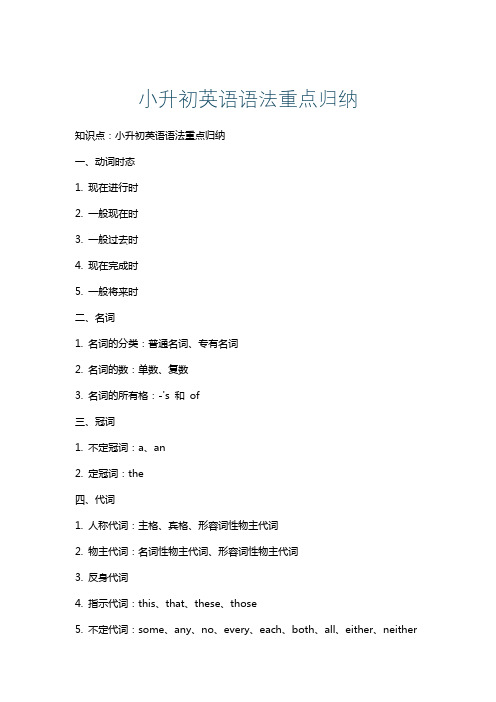
小升初英语语法重点归纳知识点:小升初英语语法重点归纳一、动词时态1. 现在进行时2. 一般现在时3. 一般过去时4. 现在完成时5. 一般将来时二、名词1. 名词的分类:普通名词、专有名词2. 名词的数:单数、复数3. 名词的所有格:-'s 和 of三、冠词1. 不定冠词:a、an2. 定冠词:the四、代词1. 人称代词:主格、宾格、形容词性物主代词2. 物主代词:名词性物主代词、形容词性物主代词3. 反身代词4. 指示代词:this、that、these、those5. 不定代词:some、any、no、every、each、both、all、either、neither等五、形容词和副词1. 形容词的比较级和最高级2. 副词的比较级和最高级3. 形容词和副词的转换六、介词1. 介词的分类:地点介词、时间介词、方向介词、方式介词等2. 介词短语七、连词1. 并列连词:and、or、but、nor、for、yet、so等2. 从属连词:because、if、although、though、until、after、before、since、lest等八、句子的类型1. 简单句2. 并列句3. 复合句4. 疑问句:一般疑问句、选择疑问句、特殊疑问句、反意疑问句5. 祈使句6. 感叹句九、被动语态1. 被动语态的构成:助动词be+过去分词2. 被动语态的时态:现在时、过去时、将来时十、主谓一致1. 名词作主语的主谓一致2. 代词作主语的主谓一致3. 不定代词作主语的主谓一致4. 并列主语的主谓一致十一、非谓语动词1. 动名词2. 分词:现在分词、过去分词3. 不定式十二、情景交际1. 问候与介绍2. 告别与感谢3. 道歉与许可4. 请求与建议5. 惊讶与祝贺本归纳文档涵盖了小升初阶段英语语法的重点知识点,旨在帮助学生巩固所学内容,为初中阶段的学习打下坚实基础。
在学习过程中,请注意理解各个语法点之间的联系,加强练习,提高英语水平。
小升初英语必备10大语法知识点汇总

小升初英语必备10大语法知识点汇总一、小学英语形容词性物主代词1、形容词性物主代词8个:My your his her its our your their我的你的他的她的它的我们的你们的他(她、它)们的2、形容词性物主代词的特点:1)译成汉语都有"的" eg:my 我的 their 他们的2)后面加名词: eg:my backpack his name3)前后不用冠词 a an theThis is a my eraser(错误) That is your a pen(错误) It's his the pen(错误)3、I(物主代词)my you(物主代词)your he (物主代词)her we (物主代词) our注:在变物主代词时,把原题所给的词加上的,再译成单词就可以了。
二、小学英语名词性物主代词1、名词性物主代词和形容词性物主代词一样有8个:Mine yours his hers its ours yours theirs我的你的他的她的它的我们的你们的他(她、它)们的2、名词性物主代词的特点:1)译成汉语都有"的" 2)后面不加名词 3)名词性物主代词=形容词性物主代词+名词Eg:1、thepen is mine 钢笔是我的(mine=my pen)三、小学英语单数的句子变成复数的句子把单数的句子成复数的句子:变法是把能变成复数的词变成复数,但a或an要把去掉。
特殊疑问词、形容词、国家及地点通常不变。
Eg:把以下句子变成复数1, I have a car ----we have cars2, He is an American boy. ----They are American boys3, It is a car ----They are cars4, This is an eraser ----These are erasers5, That is a backpsck -----Those are backpacks6,I'm an English teather ------We are English teathers7,It's a new shirt---- They are new shirts8,He's a boy ----They are boys9,She's a singer ------They are singers10,What's this in English?---- What are these in English?四、小学英语名词的数语法名词有单数和复数两种形式1、名词的单数:表示一个人或一个事物2、名词的复数:表示一个人以上的人或事物名词复数的变化规律如下:1、多数情况下在名词后面加S,s 在清辅音后读【S】2、以s,某,sh,ch为结尾的词在词尾加es, es读作【iz】3、以f,fe为结尾的词去掉f或fe加ves,ves读作【vz】4、以辅音加y结尾的词,变y 为ies5、以元音加y结尾的词,直接加s6、不规那么变化a变成eMan-menwoman-womenpoliceman-policemenPolicewoman-policewomen单复数同形Chinese-chineseJapanese-japanesesheep -sheepdeer -deer不规那么变化This 这个these这些(复数)that那个 those那些(复数)I我 we我们(复数)he他 she她 it它 they他、它、她们(复数)am ,is是 are(复数)五、小学英语人称代词主格及宾格人称代词分为主格和宾格,主格和宾格区别:主格和宾格汉语意思相同,但位置不同。
小升初语法知识点总结(二)
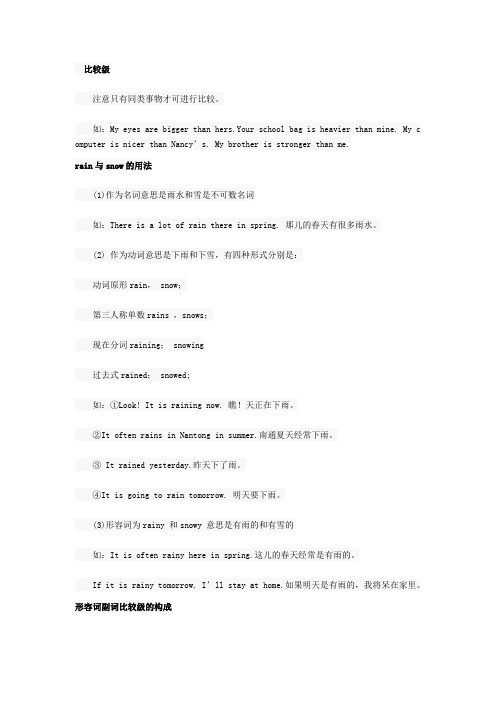
比较级注意只有同类事物才可进行比较。
如:My eyes are bigger than hers.Your school bag is heavier than mine. My c omputer is nicer than Nancy’s. My brother is stronger than me.rain与snow的用法(1)作为名词意思是雨水和雪是不可数名词如:There is a lot of rain there in spring. 那儿的春天有很多雨水。
(2) 作为动词意思是下雨和下雪,有四种形式分别是:动词原形rain, snow;第三人称单数rains ,snows;现在分词raining; snowing过去式rained; snowed;如:①Look! It is raining now. 瞧!天正在下雨。
②It often rains in Nantong in summer.南通夏天经常下雨。
③ It rained yesterday.昨天下了雨。
④It is going to rain tomorrow. 明天要下雨。
(3)形容词为rainy 和snowy 意思是有雨的和有雪的如:It is often rainy here in spring.这儿的春天经常是有雨的。
If it is rainy tomorrow, I’ll stay at home.如果明天是有雨的,我将呆在家里。
形容词副词比较级的构成规则的:(1)直接在形容词或副词后加er如;small—smaller;low—lower;(2)以e结尾的加r如:late—larer;(3)双写词尾加er如:big—bigger;thin—thinner;fat—fatter;(4)以辅音字母加y结尾的改y为i加er如:heavy—heavier;early—earlier;不规则的有:good,well—better(最高级为best);many,much---more(最高级为most);far---farther;规则动词过去式的构成(1)直接在动词后加ed如:clean—cleaned;milk—milked;play—played;(2)以e结尾的直接加d如:dance—danced;taste—tasted;(3)以辅音字母加y结尾的改y为i加ed如:study—studied;carry—carried;(4)双写词尾加ed如:stop—stopped;jog—jogged;不规则的有:am,is—was;are—were;do,does—did;have,has—had;go—went;meet—met;sit—sat;see—saw;get—got;tell—told;run—ran;come—came;stea l—stole;read—read;现在分词的构成(1)直接在动词后加ing如:sing—singing;ski—skiing;(2)双写词尾加ing如:swim—swimming;jog—jogging;run—running;(3)以不发音的e结尾的去e加ing如:ride—riding;dance—dancing;make—making;动词第三人称单数的构成(1)直接在动词后加s如:run—runs;dance—dances(2)以s,sh,ch,o结尾的加es如:do—does;go—goes;wash—washes;catch—catches(3)以辅音字母加y结尾的改y为i加es如:study—studies;carry—carries;名词复数构成的方法有规则的有:(1)直接在名词后加s如orange—oranges;photo—photos;(2)以x,s,sh,ch结尾的加es如:box—boxes;glass—glasses;waitress—waitresses;watch—watches;peach --peaches(3)以辅音字母加y结尾的改y为i加es如:study—studies;library—libraries;hobby—hobbies;family—families;(4)以f,fe结尾的改f,fe为v+es如:knife—knives;thief—thieves(注:以o 结尾的我们学过的只有mango加es,mango—mangoes其余加s,)不规则的有:man—men;woman—women;people—people;child—children时间介词季节前,月份前用介词in如:in summer;in March具体的哪一天如星期几,几月几日用介词on如:on Saturday; on the second of April; on Wednesday morning在几点钟前用介词at如: at a quarter to four;只在上下午晚上用in如:in the morning/ afternoon/ evening;但在夜间用at night。
2023年小升初江苏地区语法专项训练--数词(含答案解析)

2023年小升初江苏地区语法专项训练--数词(含答案解析)译林版三起一、单选题1.I have ______ apple.A.two B.one2.The bridge is ______.()A.four metres long B.four metre long C.fourmetres long3.I was 8 years old when my father was 31.This year my father is 42.How old am I?_____ ()A.Nineteen.B.Twenty.C.Twenty-one.D.Twenty-two.4.I played basketball in the playground __________ weekend.A.lastB.nextC.this5.——Which room are you living in, Jack?()——In Room 502 on floor.A.the three B.the third C.third D.three 6.There are _______ young monks in the temple. (《快乐英语》Unit1)()A.one B.two C.three7.选出正确的单词。
()一A.oneB.two8.—What’s two and three? ()—It’s ______.A.one B.five C.six9.---Do you like this art show? ()---Yes. I think the _________ picture is very beautiful.A.one B.first C.my first10.one+six=_________A.four B.six C.seven11.Four dogs have _______ legs. ()A.twelve B.sixteen C.eighteen12.选出不同类的单词:()A.panda B.ten C.lion13.— Do you know ________ students in our school? ()— Yes. It’s about ________.A.a number of; two hundred B.the number of; two hundredC.a number of; two hundreds D.the number of; two hundreds 14.I’m ________ year old. ()A.one B.three C.ten15.Danny lives in ________. ()A.room 404B.Room 404C.404 room D.404 Room 16.-What’s fifteen and three? ()-It’s________.A.eighteen B.eleven C.nineteen17.This _______, please. ()A.one B.two C.three 18.Saturday is the day of a week. ()A.first B.sixth C.second D.seventh 19.March is the ________ month (月) of the year. Tree Planting Day is ________ March 12th. ()A.third; on B.three; at C.fifth; in20.Class Four is on the _______ floor. ()A.three B.first C.two二、情景选择21.妈妈问你一周有多少天,你应该回答:()A.Five.B.Seven.C.Six.22.当你想告诉别人,“母亲节在五月的第二个星期日。
小升初英语过去进行时语法考点及专项练习题
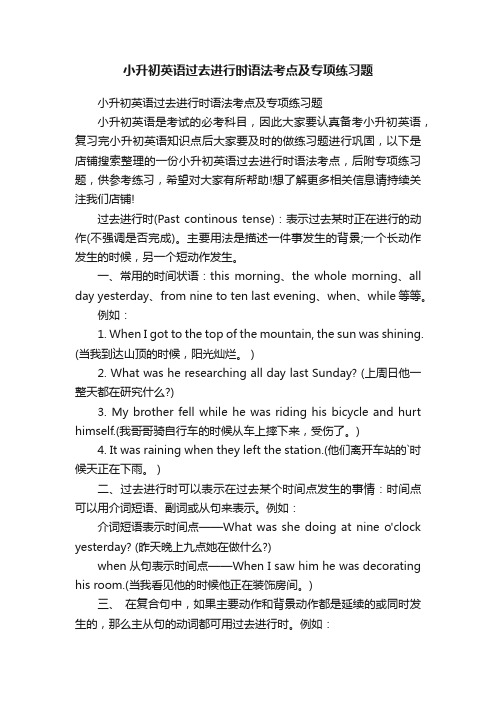
小升初英语过去进行时语法考点及专项练习题小升初英语过去进行时语法考点及专项练习题小升初英语是考试的必考科目,因此大家要认真备考小升初英语,复习完小升初英语知识点后大家要及时的做练习题进行巩固,以下是店铺搜索整理的一份小升初英语过去进行时语法考点,后附专项练习题,供参考练习,希望对大家有所帮助!想了解更多相关信息请持续关注我们店铺!过去进行时(Past continous tense):表示过去某时正在进行的动作(不强调是否完成)。
主要用法是描述一件事发生的背景;一个长动作发生的时候,另一个短动作发生。
一、常用的时间状语:this morning、the whole morning、all day yesterday、from nine to ten last evening、when、while等等。
例如:1. When I got to the top of the mountain, the sun was shining. (当我到达山顶的时候,阳光灿烂。
)2. What was he researching all day last Sunday? (上周日他一整天都在研究什么?)3. My brother fell while he was riding his bicycle and hurt himself.(我哥哥骑自行车的时候从车上摔下来,受伤了。
)4. It was raining when they left the station.(他们离开车站的`时候天正在下雨。
)二、过去进行时可以表示在过去某个时间点发生的事情:时间点可以用介词短语、副词或从句来表示。
例如:介词短语表示时间点——What was she doing at nine o'clock yesterday? (昨天晚上九点她在做什么?)when从句表示时间点——When I saw him he was decorating his room.(当我看见他的时候他正在装饰房间。
最全小升初英语语法总结-PPT-讲解与练习
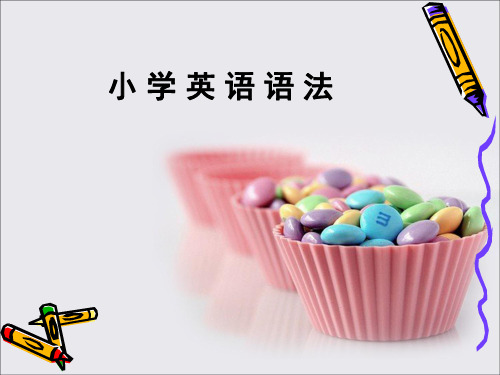
物质名词和抽象名词通常无法用数目计算,称为不可数 名词,一般只有一种形式。
英语语法中,只有可数名词才有复数 形式。名词有两种数的形式:
1)单数(表示一个人或事物);
2)复数(表示多于一个的人或数)。
可数名词
chicken (鸡,一种动物) 名词的数:fish(鱼,一种动物) an ice cream(一个冰淇淋) a tomato salad(一种西红 柿沙拉)
以-s,-sh, -ch, -x, +es -z结尾的名词 大多数以-o结 尾的有生命名 词
1. 由元音字母的变化构成: [z] tomatoes, +es man-men, tooth-teeth, foot-feet, potatoes,heroes mouse-mice, woman-women 2. 有些名词的复数形式与单数的形式一样: [z] radios, 以o结尾的无生 +s sheep, deer, fish(但也可以是fishes) pianos,photos 命名词 3. 有些名词变成复数时加-en: stories, families, 以辅音字母加y 把y改成child-children, i再 [z] ox-oxen
双重 所有格
所有格的形式 ’s结构也可以用于 “of”结构之后,如:a friend of my father’s , 出现这种情况是因为在一个名词前通常只 单数人称名词末尾加 ’s child用一个限定词,又如:this son of mine, a friend of child’s yours, a cousin of hers等等。 以-s结尾的单数人称名词末尾加’s waitresswaitress Isn’t Frank ’s a friend of yours? That silly uncle of Tom’s has told me the same 不规则的复数人称名词末尾加’s childrenJoke five times. children’s
小升初英语经典语法总结(8篇)
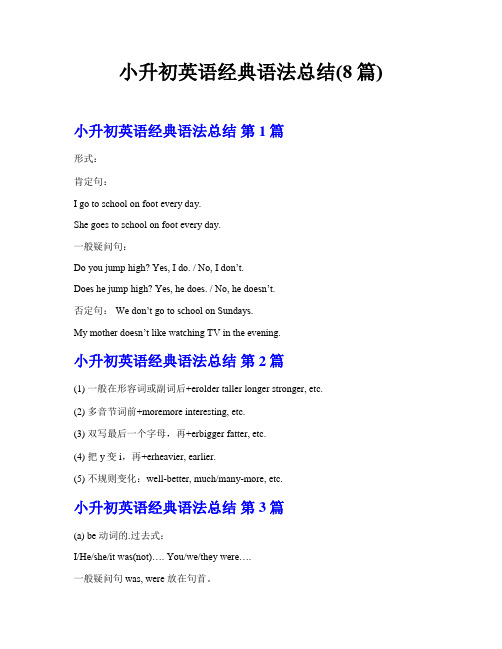
小升初英语经典语法总结(8篇)小升初英语经典语法总结第1篇形式:肯定句:I go to school on foot every day.She goes to school on foot every day.一般疑问句:Do you jump high? Yes, I do. / No, I don’t.Does he jump high? Yes, he does. / No, he doesn’t.否定句:We don’t go to school on Sundays.My mother doesn’t like watching TV in the evening.小升初英语经典语法总结第2篇(1) 一般在形容词或副词后+erolder taller longer stronger, etc.(2) 多音节词前+moremore interesting, etc.(3) 双写最后一个字母,再+erbigger fatter, etc.(4) 把y变i,再+erheavier, earlier.(5) 不规则变化:well-better, much/many-more, etc.小升初英语经典语法总结第3篇(a) be 动词的.过去式:I/He/she/it was(not)…. You/we/they were….一般疑问句was, were 放在句首。
(b) 动词过去式:肯定句: I watched cartoons.She visited the zoo.一般疑问句:Did you read book last night? Yes, I did. No, I didn’t. Did she clean the desk just now? Yes, she did. No, she didn’t.否定句:They didn’t go the the part yesterday.He didn’t make model ships last week.(3)动词过去式的变化:规则动词的变化:Most verbs +ed eg. planted,watered,climbed。
2023年小升初 江苏地区语法专项训练--祈使句和感叹句(含答案解析)译林版三起
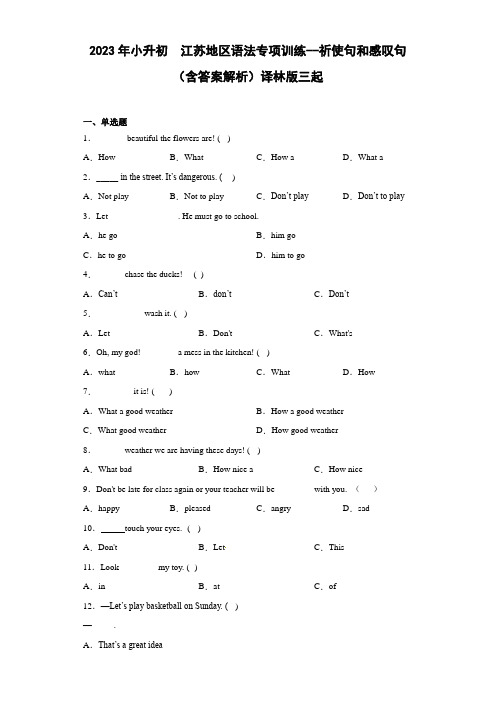
12.—Let’s play basketball on Sunday. ()
—_____.
A.That’s a great idea
B.You’re welcome
C.That’s right
D.That’s all right
13.________ eat too many sweets. It’s bad for your teeth. ()
B.Don’t turn on
C.Not turn down
D.Don’t turn down
42.吃些鱼肉吧,你怎么说:__________()
A.Have some fish.B.Here are some fish
43._______ dirty table! Let’s clean it up. ()
17.当你提醒小明不要在房间玩球时,说:
A.Don't read in bed, Xiaoming !
B.Don't be late for school, Xiaoming !
C.Don't play ball in the room, Xiaoming !
18.—Look, Sam! The traffic light is yellow! _________!()
A.NoB.DoC.NotD.Don’t
14.---Don’t forget to close the window. ()
---__________.
A.Yes, I won’tB.No, I willC.Yes, I willD.No, I won’t
15.—Let's put up the pictures.()
【新版】最全小升初英语语法点(总结及练习)
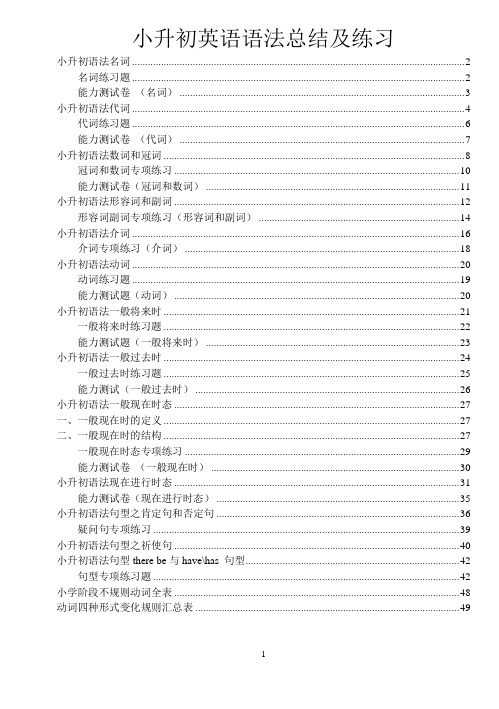
小升初英语语法总结及练习小升初语法名词 (2)名词练习题 (2)能力测试卷(名词) (3)小升初语法代词 (4)代词练习题 (6)能力测试卷(代词) (7)小升初语法数词和冠词 (8)冠词和数词专项练习 (10)能力测试卷(冠词和数词) (11)小升初语法形容词和副词 (12)形容词副词专项练习(形容词和副词) (14)小升初语法介词 (16)介词专项练习(介词) (18)小升初语法动词 (20)动词练习题 (19)能力测试题(动词) (20)小升初语法一般将来时 (21)一般将来时练习题 (22)能力测试题(一般将来时) (23)小升初语法一般过去时 (24)一般过去时练习题 (25)能力测试(一般过去时) (26)小升初语法一般现在时态 (27)一、一般现在时的定义 (27)二、一般现在时的结构 (27)一般现在时态专项练习 (29)能力测试卷(一般现在时) (30)小升初语法现在进行时态 (31)能力测试卷(现在进行时态) (35)小升初语法句型之肯定句和否定句 (36)疑问句专项练习 (39)小升初语法句型之祈使句 (40)小升初语法句型there be与have\has 句型 (42)句型专项练习题 (42)小学阶段不规则动词全表 (48)动词四种形式变化规则汇总表 (49)小升初语法名词一、名词复数规则1.一般情况下,直接加-s,如:book-books, bag-bags, cat-cats, bed-beds2.以s. x. sh. ch结尾,加-es,如:bus-buses, box-boxes, brush-brushes, watch-watches 3.以“辅音字母+y”结尾,变y为i, 再加-es,如:family-families, strawberry-strawberries以“元音字母+y”结尾,直接加s,如:boy - boys ,day - days4. 以“f或fe”结尾,变f或fe为v, 再加-es,如:knife-knives5.以o结尾的单词:a, 有生命的+es b, 无生命+s如:potato--potatoes ;hero--heroes;mango--mangoesphoto--photos ; radio -- radios ; video -- videos6. 不规则名词复数:man-menwoman-women policeman-policemen mouse-micechild-children foot-feettooth-teethfish-fishpeople-peopleChinese-ChineseJapanese-Japanesedeer - deersheep-sheeppolicewoman-policewomen二、名词所有格的构成法1. 主要是在词尾加’ s 构成。
(完整版)小升初英语语法总结+练习题及答案

(完整版)小升初英语语法总结+练习题及答案小升初英语语法总结+练习题及答案1、人称代词主格:I we you she he it they宾格:me us you her him it them形容词性物主代词:my our your her his its their名词性物主代词:mine ours yours hers his its theirs一;用适当的代词填空。
1.Is that car yours? Yes, it is ______.2.How is Mr Li? _______is fine, thanks.3.Put on______ hat! I am going to put it on.4.Who is that over here? It is_______.5.The old man lives by ______.6.I am sure I can do it all by _______.7.Look,is this room beautiful? I painted it _____.8.I’d like to go for a walk. ______ too.9.What are ______jobs? They are students.10.We think to _________.11.Mary is old enough to take care of ______.12.It is perfume, I made it __________.13.Look at ____. She is very well.14.Can you carry this box upstairs by _______.15.You and she did very well in the test.The teacher said that he would praise _____ and______.16.The story ______was very good, but you are did not tell it well.17.Give Jane this watch.. Give______ this one too.18.Sara is not pleased with ______in this English test.19.Did you enjoy _______at the party yesterday?20.She wants to buy a car of _____own.二:选择填空.1. Mr. More has more money than Mr. Little . But he doesn’t enjoy _______.A. heB. himC. hisD. himself2. Lily was 9 years old. _____ was old enough to go to school ________.A. She , sheB. She , herselfC. Her, herselfD. Her. she3. Jim’s watch is much newer than _________.A. hersB.sheC. herD. herself4.Would you like _____for super?A: something Chinese B:Chinese somethingC: anything Chinese D: Chinese anything5.______ piano is too old ,but she still liked playing it.A. SheB. She’sC. HersD. Her6.Who taught you English last year?Nobody taught me . I taught ______.A. meB. myselfC. mineD. I7.That bike is _________?A.he B. him C. his D. it8. We bought ______ a present, but _______ didn”t like it.A. they, themB. them , theyC. themselves , theirD. theirs, they答案:1. mine2. he3. your4. her5. here6. myself7. myself8. me9. those10. ourselves11. herself12. myself13. her14. yourself15. you, her16. you made17. her18. her results19. yourself20. her1. D2. B3. A4. C5. D6. B7. C8. B2.形容词和副词的比较级(1) 一般在形容词或副词后+erolder taller longer stronger, etc(2) 多音节词前+moremore interesting, etc.(3) 双写最后一个字母,再+erbigger fatter, etc.(4) 把y变i,再+erheavier, earlier(5) 不规则变化:well-better, much/many-more, etc.3.可数词的复数形式一、名词复数规则1.一般情况下,直接加-s,如:book-books, bag-bags, cat-cats, bed-beds2.以s. x. sh. ch结尾,加-es,如:bus-buses, box-boxes, brush-brushes, watch-watches 3.以“辅音字母+y”结尾,变y为i, 再加-es,如:family-families,strawberry-strawberries4.以“f或fe”结尾,变f或fe为v, 再加-es,如:knife-knives 5.不规则名词复数:man-men, woman-women, policeman-policemen, policewoman-policewomen, mouse-micechild-childrenfoot-feet,.tooth-teethfish-fish, people-people, Chinese-Chinese, Japanese-Japanese写出下列各词的复数I _________him _________this ___________her ______watch _______child _______photo ________diary ______day________ foot________ book_______ dress ________tooth_______ sheep ______box_______ strawberry _____thief _______yo-yo ______ peach______ sandwich ______man______ woman_______ paper_______ juice___________water________ milk________ rice__________ tea__________4.不可数名词(单复数形式不变)bread, rice, water ,juice etc.5. 缩略形式I’m = I am you’re = you are she’s = she is he’s = he is it’s = it is who’s =who is can’t =can not isn’t=is not etc6 冠词冠词的定义冠词是置于名词之前,对名词起限制作用的一种虚词。
江苏省小升初语法专题:时态应用真题分类汇编(含答案)
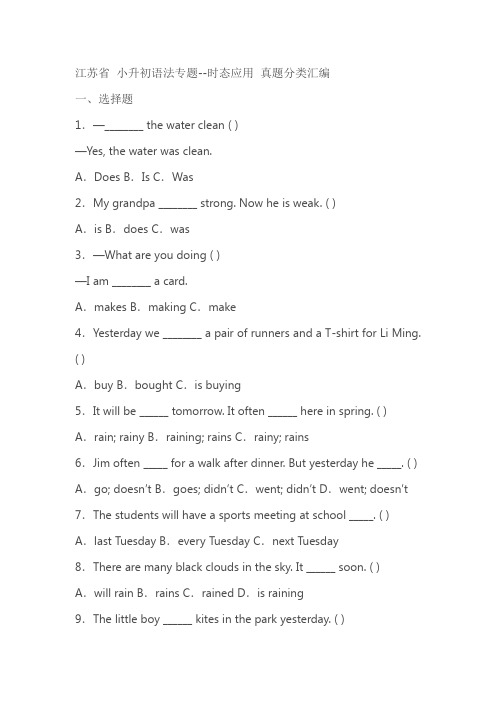
江苏省小升初语法专题--时态应用真题分类汇编一、选择题1.—________ the water clean ( )—Yes, the water was clean.A.Does B.Is C.Was2.My grandpa ________ strong. Now he is weak. ( )A.is B.does C.was3.—What are you doing ( )—I am ________ a card.A.makes B.making C.make4.Yesterday we ________ a pair of runners and a T-shirt for Li Ming. ( )A.buy B.bought C.is buying5.It will be ______ tomorrow. It often ______ here in spring. ( ) A.rain; rainy B.raining; rains C.rainy; rains6.Jim often _____ for a walk after dinner. But yesterday he _____. ( ) A.go; doesn’t B.goes; didn’t C.went; didn’t D.went; doesn’t 7.The students will have a sports meeting at school _____. ( ) A.last Tuesday B.every Tuesday C.next Tuesday8.There are many black clouds in the sky. It ______ soon. ( ) A.will rain B.rains C.rained D.is raining9.The little boy ______ kites in the park yesterday. ( )A.flew B.fly C.flies10.—_______ he going to Hong Kong next week ( )—No, he _______.A.Does; doesn't B.Is; isn't C.Will; won't11.From then on, the lion and the mouse _______ good friends. ( ) A.to become B.becomes C.became12.I _______ some chocolate _______ the shop yesterday evening. ( ) A.bought; to B.bought; from C.bought; about13.It often _______ in spring in Huai'an. Look. It is _______ now. ( ) A.rains; raining B.raining; rainy C.rained; rainy14.Don't shout, Tim. Your father _______. ( )A.sleep B.sleepy C.is sleeping15.—Where _______ you last week ( )—I _______ in Shanghai.A.was; was B.was; were C.were; was16.There ______ some bread in the fridge yesterday. ( )A.are B.were C.was17.Where are you going ______ ( )A.yesterday B.tonight C.before18.We _______ basketball last weekend. ( )A.played the B.play C.played19.My shoes ________ under the bed just now. But they ________there now. ( )A.a re; weren’t B.were; weren’t C.were; aren’t二、填空题20.—Who (fly) the kite there—Helen is.21.She feels very t and she n some water.22.We (have) a party at school next week.23.My mother (take) me to school by car this morning. 24.Miss Li is a quiet woman. She often (stay) at home. 25.When I was a little girl, my grandma (tell) me many (story). 26.The little boy (can) read because he was too young. 27.There’s nothing in the bowl. Who (eat) the noodles in it 28.The children (swim) now.29.Anderson is a good . He (write) stories for children many years ago.30.Sometimes my mum TV after supper.31.This morning, Lily up very early.32.Tom often (感到困倦) in the morning. Because he (睡觉晚) at night.33.We’re good friends. I (很了解他).34.People in Wuxi (欢迎游客).35.David always (fly) kites in spring.36.My brother (finish) his homework yesterday evening. 37.There (not be) any orange juice in the fridge yesterday. 38.Jim likes painting. He (paint) pictures every evening.三、句型转换39.My parents like music. (改为同义句)40.She is in her room. (对划线部分提问)41.Tom does homework every day. (变为一般疑问句)42.We brought some new books for Jack. (改为一般疑问句)you new books for Jack43.I want to be an artist some day. (对画线部分提问)do you want to some day44.Liu Tao comes from China. Mike comes from China, too. (合并为一句话)Liu Tao and Mike come from China.45.John took the bus to the park last Sunday. (对划线部分提问) John take the bus to the park46.She will buy some presents on Children’s Day.(改为否定句) She buy presents on Children’s Day.47.Uncle John is a driver. (对画线部分提问)What Uncle John48.The old man is short and weak. (改为反义句)The young man is and .49.We are going to have the party at 5:30. (改为一般疑问句) Are to have the party at 5: 3050.My sister wants to be an English teacher. (对划线部分提问) does your sister to be51.Tom woke Bobby up just now. (用tomorrow改写)Tom Bobby up tomorrow.52.The cat ate the fish last night. (改为否定句)The cat the fish last night.53.I will go to Beijing next week. (改为一般疑问句)go to Beijing next week参考答案:1.C【详解】句意:—水干净吗?—是的,水很干净。
- 1、下载文档前请自行甄别文档内容的完整性,平台不提供额外的编辑、内容补充、找答案等附加服务。
- 2、"仅部分预览"的文档,不可在线预览部分如存在完整性等问题,可反馈申请退款(可完整预览的文档不适用该条件!)。
- 3、如文档侵犯您的权益,请联系客服反馈,我们会尽快为您处理(人工客服工作时间:9:00-18:30)。
小升初英语总结及练习名词 ....................................................................................................................................................基础练习题 ................................................................................................................................能力提升题 ................................................................................................................................ 代词 ....................................................................................................................................................基础练习题 ................................................................................................................................能力提升题 ................................................................................................................................名词一、名词复数规则二、1.一般情况下,直接加-s,如:book-books, bag-bags, cat-cats, bed-beds三、2.以s. x. sh. ch结尾,加-es,如:bus-buses, box-boxes, brush-brushes, watch-watches四、3.以“辅音字母+y”结尾,变y为i, 再加-es,如:family-families, strawberry-strawberries以“元音字母+y”结尾,直接加s,如:boy - boys ,day - days4. 以“f或fe”结尾,变f或fe为v, 再加-es,如:knife-knives5.以o结尾的单词:a, 有生命的+es b, 无生命+s如:potato--potatoes ;hero--heroes;mango--mangoesphoto--photos ; radio -- radios ; video -- videos6. 不规则名词复数:man-menwoman-women policeman-policemen mouse-micechild-children foot-feettooth-teethfish-fishpeople-peopleChinese-ChineseJapanese-Japanesedeer - deersheep-sheeppolicewoman-policewomen二、名词所有格的构成法1. 主要是在词尾加’ s 构成。
如:This is Tom’s desk . 这是汤姆的书桌。
That is Mike’s book. 那是迈克的书。
2. 如果原名词已经有复数词尾s ,则仅加一个’ . 如:the teachers’ reading room 教师阅览室the pupils’ pencil-boxes 学生们的文具盒3. 如果原词是复数形式,但不是以s 结尾,变为所有格形式需在后面加上’ s 。
如:the children’s palace 少年宫men’s room 男厕所*名词所有格口诀:名词所有格,s前面加一撇’,复数s放在尾,后加一撇就完结,两人共有算一个,后面只加一个撇。
基础练习题一、写出下列名词的复数形式puter ____________2.apple ____________3.city ______________4.house _____________5.sheep _____________6.watch ______________7.tomato _____________8.child _____________9.tooth ________10.foot ______________ 11.wife _____________ 12.potato ____________ 13.play _____________ 14.day ____________ 15.glass ______________ 16.radio ______________ 17.zoo ______________ 18. life ______________ 19. story _____________ 20.leaf _____________ 21. baby _____________ 22.dress _____________ 23.butterfly _____________ 24. deer _____________ 25.class _____________ 26.brush _____________ 27.key _____________28. English ____________29.mouse ____________ 30. man _____________二、汉译英1.Tom的足球_________________ 2. 老师们的自行车_________________ 3.学生们的课桌_________________ 4.哥哥的文具盒_________________ 5.姑姑的卡片_________________ 6.猴子们的香蕉_________________ 7.蚂蚁们的早餐_________________ 8.妈妈的包_________________ 9.姐姐的连衣裙_________________ 10女孩们的苹果_________________ 三、把下列句子翻译成英文1.这些是Peter的篮球吗?________________________________________ 2.这个是老师的钢笔吗?___________________________________________ 3.有一些书在Sam的课桌上。
________________________________________ 4.有一些孩子们在教室里。
___________________________________________四、改错(圈出错处,在横线上改正过来)1.There are some butterflys on the table. ________________________2.This is Alice dress. ______________________3.I like tomato very much. __________________五、将下列句子变成复数形式。
1.This dog is brown.___________________________________________________2. There is a book and a pen on the table.___________________________________________________3.That woman is a teacher.___________________________________________________能力提升题一、将下列名词变成复数形式。
1. plane tree lessonmonth apple shirt2.box bus brushwatch class fox3. knife life leafWife thief4. day boy monkeybaby country story5. photo radio pianotomato hero6.child tooth manSheep English Chinese二、判断正误,并改正错句,正确的打“ √ ”1.The house is my brother. ________________________2. He has visited many country. ______________________3. They are Englishs. ______________________________4. This is Tom red bike. ____________________________三、选择填空1.There are two ______ in the room.A. ChinesesB. Englishman2.The old man will have ___________ out.A. two toothsB. two teeth3. ____________ are sold in this bookstore.A. Children’s booksB. Children books4. Some friends of _________ will come here.A. John’sB. John5. Can you give me ______________A. some papersB. a piece of paper6.There are ______________ on the floor.A. some boxB. some boxes四、将下列句子变成复数形式。
1.This sheep is white __________________________________2. There is a desk and a chair in the room._____________________________3.That man is a doctor. ________________________________代词一、人称代词人称代词即表示“你、我、他、你们、我们、他们”等的词,人称代词有主格和宾格两种形式。
